Best Cycling Routes in the Dolomites: 5 Epic Bucket List Routes with GPX & Insider Tips
The Dolomites are widely recognized as a dream destination for cyclists. Having ridden there regularly for the last 10 years, I can definitely vouch for that: fantastic roads, unbelievable scenery, challenging but not impossible climbs, all steeped in Giro d’Italia lore...
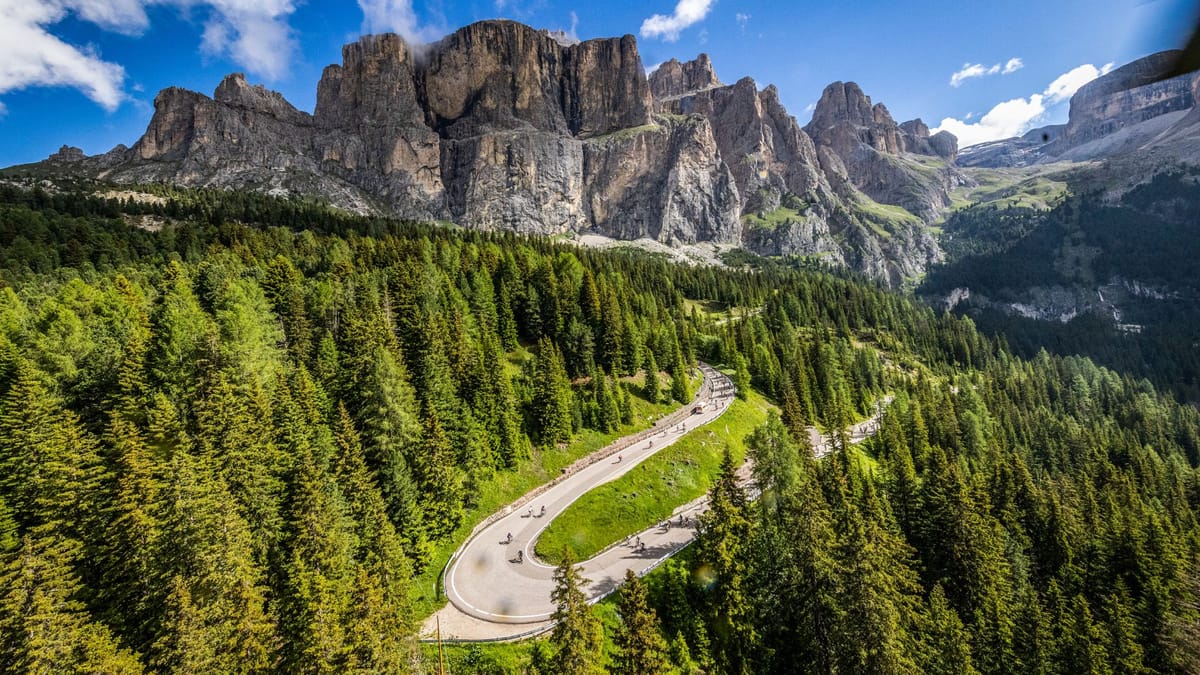
The Dolomites simply have to be ridden to be believed. Fantastic roads, unbelievable scenery, challenging but not impossible climbs, all steeped in Giro d’Italia lore. However, the Dolomites area is quite expansive and somewhat labyrinthine, which means you could easily end up on the wrong side of a mountain, facing a significant amount of additional climbing to return home. It’s taken me years of cycling and skiing in the Dolomites (I know, hard life for this Canadian!) to start to get my head around it, and I'm still learning.
This guide is a distillation of what I’ve learned as a cyclist to be the best way to experience this beautiful region on a bike. But before we get to my top 5 cycling routes in the Dolomites, here are a few practical tips for planning your trip.
Best Time to Cycle in the Dolomites
The best months to ride in the Dolomites are mid-June, July, late August, September and even early October. The beginning of June and later into October are also options, as the weather is usually still decent, but you will find a lot of the towns shut down off-season, with a limited selection of hotels and restaurants to choose from.
You might have noticed I left out the first few weeks of August, despite the nice weather at this time of year. That’s because of Ferragosto, an Italian holiday that turns into a three-week travel surge. Roads get crowded with cars and motorcycles, hotels require week-long stays, and prices skyrocket.
Also, unless you're riding the Maratona dles Dolomites (July 6, 2025), I’d avoid that weekend: it’s an amazing event if you are not riding it there will be serious FOMO, and many of the suggested routes below are closed to non-participants on race day.
How to Get to the Dolomites for a Cycling Trip
Technically part of the Italian Alps, but actually quite far from the rest of this mountain range, the closest major airport to the Dolomites is Venice Marco Polo (VCE), with Treviso (TSF) as another option for European flights. Innsbruck (INN) is also viable, with train connections to Bressanone (Brixen) and Fortezza (Franzenfeste).
If you prefer public transport, Cortina Express and FlixBus run services to Cortina, and allow bikes for an extra fee. However, reaching Corvara or other Dolomites cycling bases requires additional bus connections, and not all buses accept bikes.
Where to Stay in the Dolomites for the Best Cycling Experience
The best places to stay for cycling in the Dolomites depend on your priorities:
- Cortina d’Ampezzo
A top pick for its accessibility, infrastructure, and year-round appeal. With the 2026 Winter Olympics approaching, Cortina stays lively even in the off-season. However, riding the Sellaronda from Cortina is a tough day in the saddle with 3,500m (11,500 ft) of climbing. - Corvara (Alta Badia)
Many consider Corvara the best base for a Dolomites cycling adventure. It sits on the Sellaronda route, right at the foot of Passo Campolongo and Passo Gardena, and is the Maratona dles Dolomites finish line. Nearby towns like La Villa, Colfosco, and San Cassiano offer a similar experience. - Arabba
A more affordable alternative to Corvara, still on the Sellaronda route and closer to the Passo Giau and Passo Fedaia.
Best bet: Combine stays in Cortina and Corvara for a complete Dolomites cycling experience, just like we do on our Into the Dolomites tour.
Renting a Road Bike in the Dolomites: What You Need to Know
Renting a bike is a great option, especially if you’re traveling without a car. Cortina and Alta Badia (South Tirol) offer high-quality road, gravel, and e-bikes, but prices are on the higher side.
Pro tip: Book your rental as early as possible to get your preferred bike and size, especially in peak season.
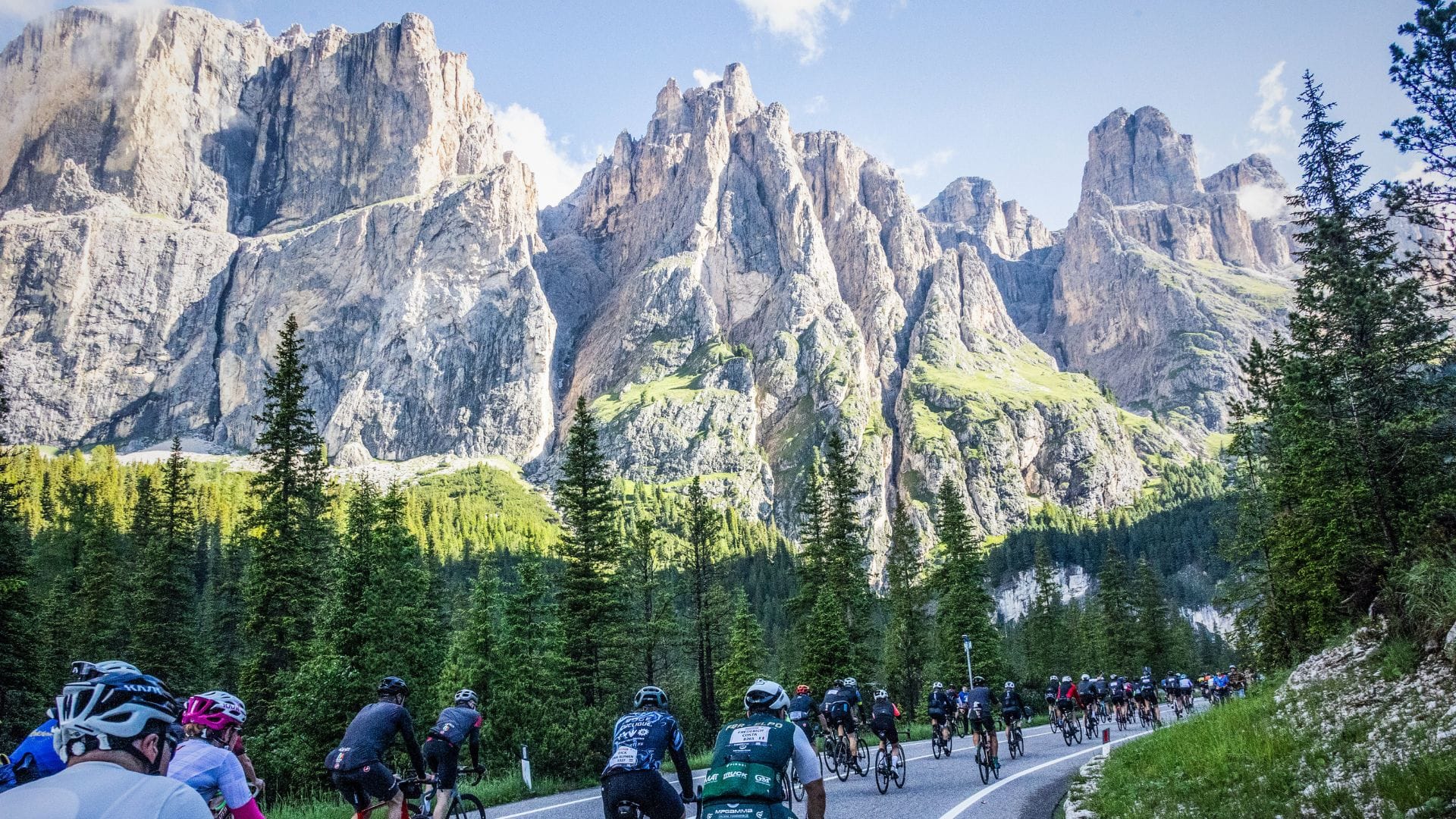
What to Pack for Cycling in the Dolomites
Weather in the Dolomites can change fast, so smart packing is essential. Even during the height of summer, it's wise to pack:
- A light windproof jacket and extra base layers, essential for not getting cold on the descents.
- A cycling cap to wear under your helmet on the descents to prevent chills after sweaty climbs.
- Long-fingered gloves and shoe covers are a must if you're a morning person, as it can be quite chilly before the sun's out.
- Arm and leg warmers are a good idea especially if you are visiting in June or later in September or early October.
- I also like to have an ‘Ass Saver’ or other portable fender with me, as wet stretches of road from melting snow are common even on dry days.
Of course if you forget something, bike shops in Cortina and the villages of the Alta Badia stock most essentials.
Cycling at Altitude in the Dolomites: How to Prepare
At over 5,000 feet (1,500m) in Corvara and 7,500 feet (2,300m) on the high passes, you’ll feel the altitude at first, especially when walking uphill after arrival. Expect a small power drop, but most riders adjust within 3 days.
Bonus: When you return home (unless you live in Denver!), you’ll feel like a cycling god; enjoy that extra gear while it lasts!
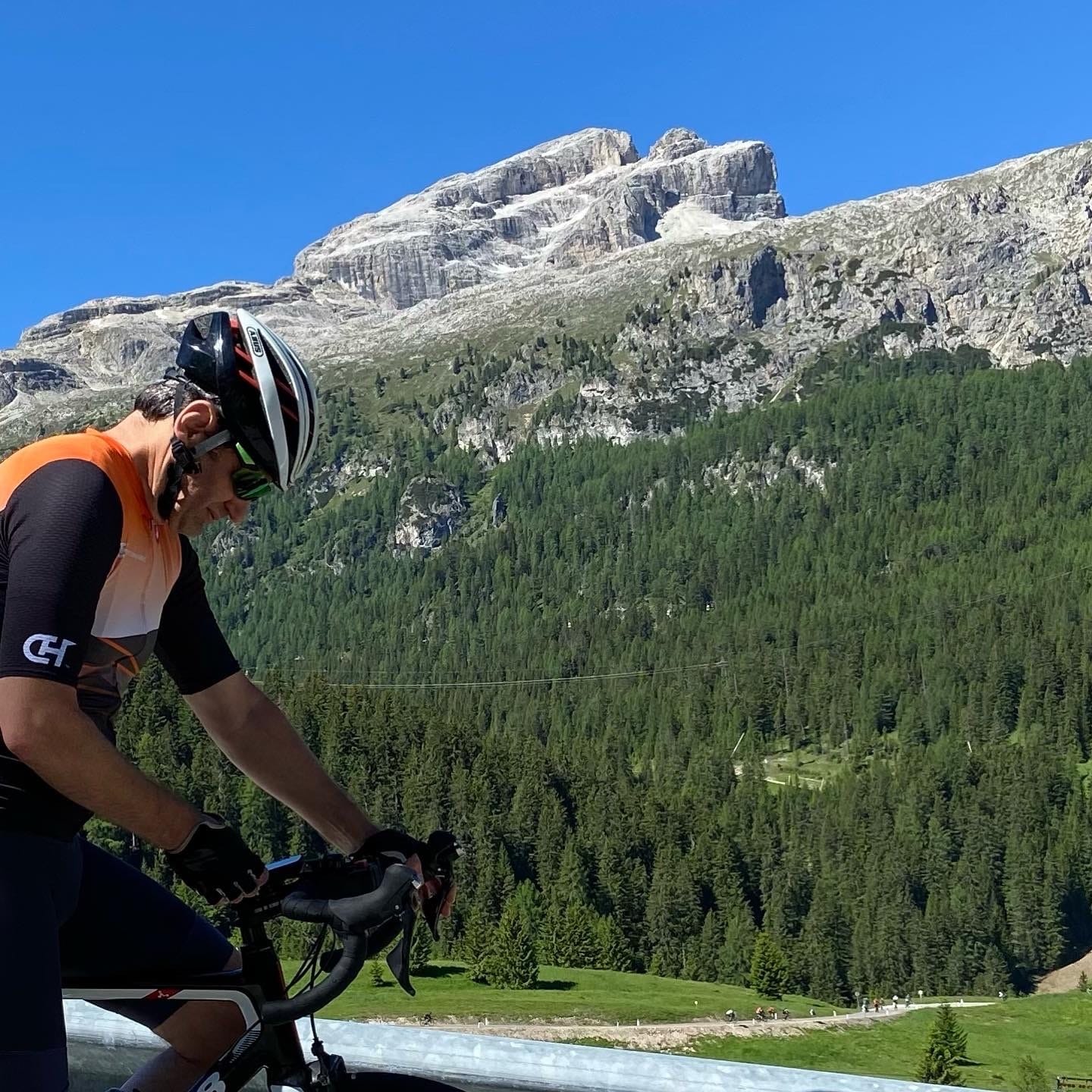
5 Epic Dolomites Cycling Routes: My Top Picks with GPX Files and Insider Tips
Before we dive in, I would just like to point out that this is obviously not an exhaustive list, and that there are many other great cycling routes to be had in the Dolomites. Also, I have picked ones that are more on the challenging end of the scale, perfect for cyclists looking to make a major dent in their "Best climbs in the Dolomites" bucket list.
Also, all ride descriptions assume starts from Cortina d’Ampezzo or Corvara, as this is where we are based on our CyclingHero Dolomites trips. If you’re looking for flatter rides, there are options along the valleys that offer views of the Dolomites from a distance, but this is the topic for another post.
And one last thing to remember: if you don't think you can make it up these climbs under your own power, an eRoad bike will give you that little extra boost to open up a whole world of cycling beauty.
Ok, enough preamble: let’s dive into the most epic cycling routes in the Dolomites!
1. Sellaronda Classic Loop (clockwise) from Corvara
Length: 51.4 km → 31.9 miles
Total climbing: 1710 m → 5610 feet
It’s no surprise that the Sella ronda loop tops this list. Often billed as the most beautiful bike ride in the world, this legendary route delivers everything a cyclist could dream of: four iconic mountain passes, stunning alpine scenery, and serpentine descents. However, what it doesn’t really deliver is an easy ride. This is a full-on Dolomites mountain challenge, with sections that push into double-digit gradients.
If you can sustain a Zone 3 effort for an hour, you should be fine. If you’re not sure what that means, you might not be fine!
Although it can be done in either direction, my preference is clockwise, as done in the Maratona dles Dolomites. There are a few reasons for this:
- Passo Campolongo: the perfect warm-up
The Passo Campolongo as the first climb is a perfect warm up for the loop: it’s not too hard, not too steep, and has a flat section in the middle to recover a bit after the first effort up the switchbacks out of Corvara. Passo Gardena is the alternative first climb in the other direction, but it’s longer, steeper, and offers little respite, a much tougher way to begin your ride.
Pro tip: Before heading up the Campolongo or the Gardena, we recommend doing a short warm-up loop around Corvara. Ride up the main road towards the Passo Campolongo, turn right after the Audi display, turn right again at the end of the road after passing the Boè lift station, then follow the road back to the roundabout and take the first exit to get you back on the main road. Repeat until you break a sweat.
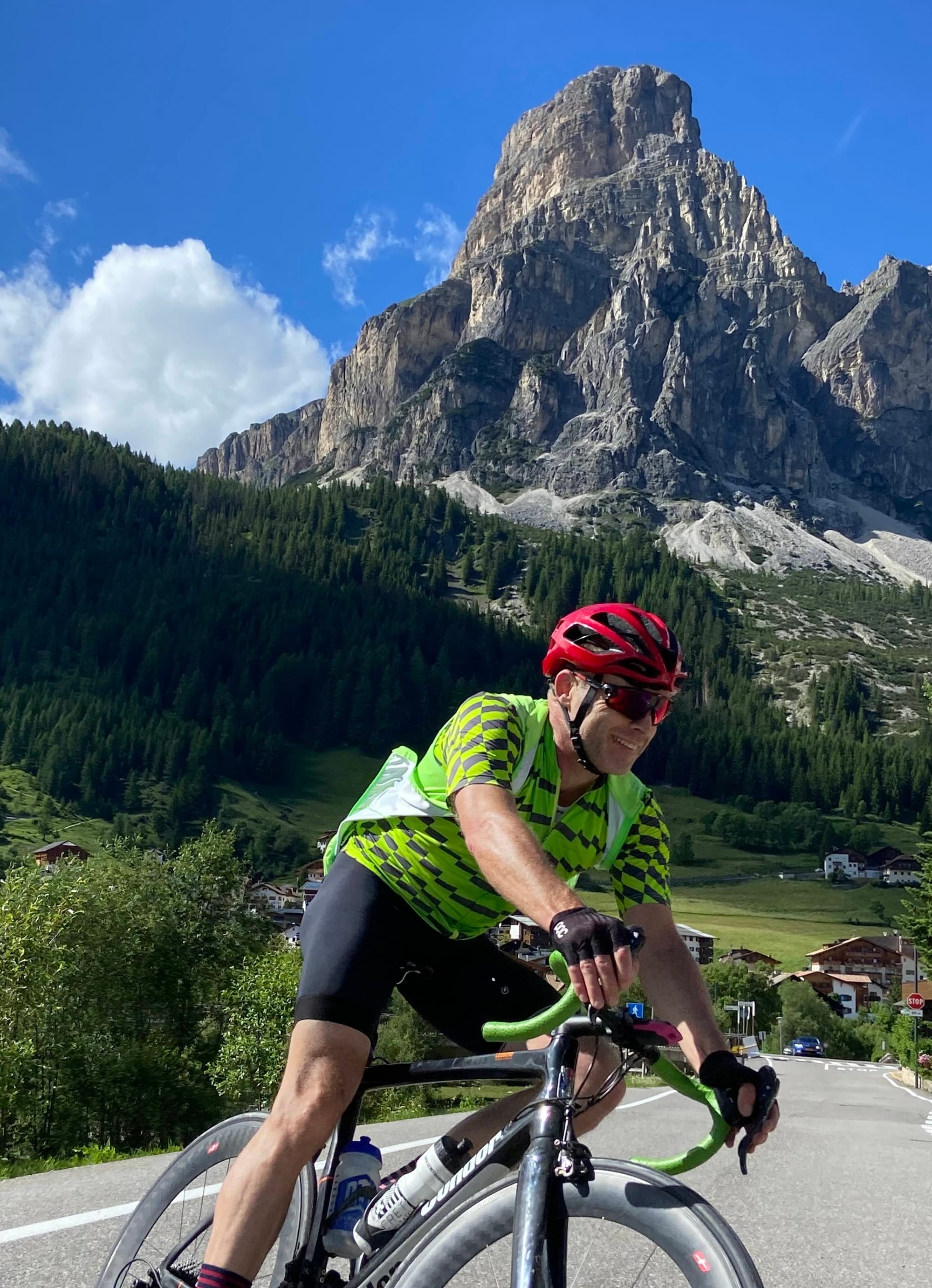
- Passo Pordoi: the best Dolomite climb (IMHO)
Climbing Passo Pordoi from Arabba is is my favourite of all the climbs on the Sellaronda loop. With its beautifully varied serpentine route, it maintains a fairly steady gradient and offers huge vistas to gawk at, helping to take your mind off the pain.
- Passo Sella and Passo Gardena: the grand finale
After conquering the Pordoi, the hardest part of the day is behind you, and it's time to enjoy the final two passes.
Although it’s relatively short, the Passo Sella from Pian Schiavaneis has some steeper bits that demand respect (and your smallest cog). As with all the passes, enjoy the view at the summit, but don’t linger too long, especially if it's a little chilly. It is very hard to get back on the bike for the descent once you are shivering and your legs have closed shop for the day.
The Passo Gardena, your final effort, happens in two stages. The first bit gets you up to a ridge that leads to the final switchbacks to the pass. There is a nice espresso and cake stop part of the way up this first part of the Gardena, but don't get carried away with the Apfelstrudel, you still have a bit more climbing to do afterwards. As the view opens up after the last switchbacks up to the top of the Passo Gardena, congratulate yourself on completing the most beautiful bike ride in the world.

Tldr: Why Ride the Sellaronda?
- Four iconic Dolomite passes in one ride. This will put a major dent in your bucket list
- Unbeatable scenery, from beautiful valley towns to jagged Dolomite peaks
- A true cycling challenge, but doable with good fitness (or an e-road bike!)
2. Sellaronda (counterclockwise) plus Giau Loop from Corvara
Distance: 114 km → 70.8 miles
Total climbing: 3590 m → 11,778 feet
Yes, the Sellaronda counterclockwise loop is also my second pick, but let me explain. First, this is the official direction of the Sellaronda Bike Day and offers a very different experience and set of views. Second, instead of finishing with the ‘relatively tame’ Campolongo climb (the 'blue pill'), you take the ‘red pill’ and continue towards the formidable Passo Giau.
Disclaimer: The ‘pill’ references are inspired by The Matrix and are in no way an endorsement of performance-enhancing substances.
The route
- Starting in Corvara, head up Passo Gardena through Colfosco. Continue along this road as it zigs and zags it's irregular way to the top, where you will be greeted by the spectacular Val Gardena amphitheatre opening up in front of you; the Sella Group on your left side; the Cir Group on your right; and the majestic Sasso Lungo (Langkofel) directly in front of you.
- After the first few downhill switchbacks from the Gardena, you traverse a flat stretch, then continue down to the intersection with the road coming from Selva di Val Gardena (Wolkenstein). Turn left and be ready with the small ring, as the road starts climbing pretty much right away towards the Passo Sella. Enjoy some more great views, and a relatively constant ascent.
- From atop the Passo Sella, there are tight switchbacks down to a flatter stretch with a couple of restaurants. Rifugio Monti Pallidi is a great stop for coffee and a water refill.
- Shortly after the rifugio, turn left and join the road up to Passo Pordoi. Since you’re already partway up, the Pordoi from this side is relatively short and sweet. Spectacular Dolomite views are your reward at the top before a wonderful, flowing descent into Arabba.
- Refill your bottles at the fountain near the church in Arabba, then continue downhill towards Andraz.
- Decision point: at Andraz, you could bypass Passo Giau via the easier Passo Falzarego but resist the temptation and continue towards Selva di Cadore. Look out for the precariously positioned Chiosco Bar da Silver on your right shortly after the nasty little uphill to Colle Santa Lucia, which offers fantastic views and a last dose of caffeine before taking on the Giau.
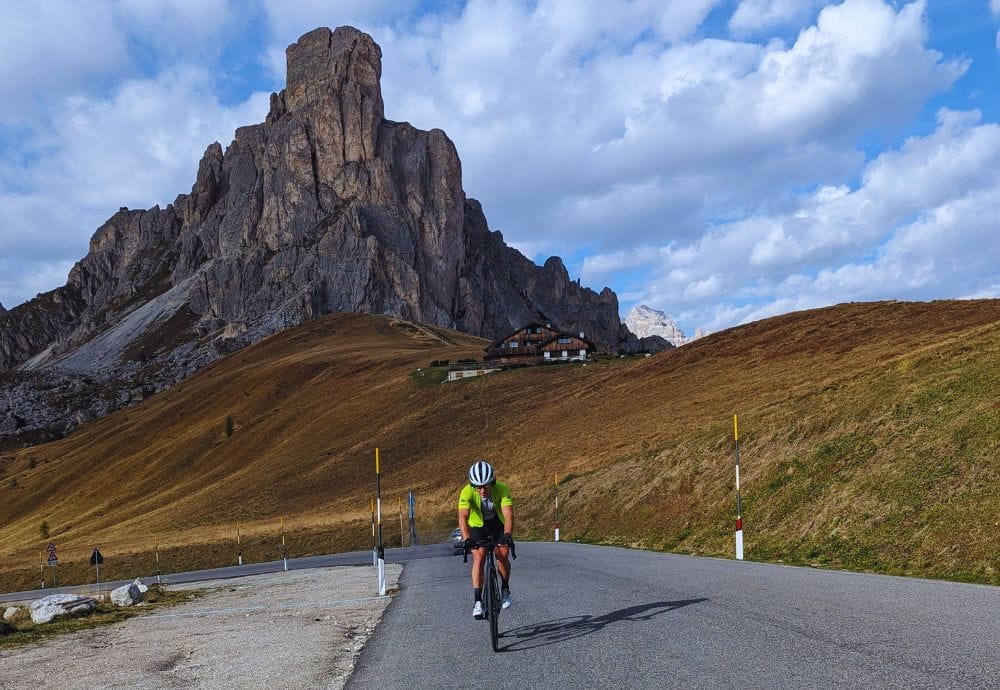
- After crossing the Codalonga river, get ready to dump it into the small ring, as there is no gentle easing in, just straight up to 10%. I find this first part of the Passo Giau the hardest mentally, as there are no mountain views visible yet to distract from the effort.
- After about switchback 13 things start to open up, but you still cannot see how much further you have to go, which is probably best. I would love to say it gets easier towards the top, but it doesn't, it just becomes more spectacular as the Averau and Nuvolau peaks tower above.
- The biker-friendly restaurant at the summit is great for a quick refuel, but keep moving, your ride isn’t over!
The home stretch:
- Descend the ‘easy’ side of the Giau to Pocol. Turn left away from Cortina and tackle the final two climbs: Passo Falzarego and Passo Valparola.
- Having conquered the Giau, the Passo Falzarego will feel like a cake walk in comparison, with just a few harder sections along the way. Take a short break at the three way intersection at the pass to admire the steep Lagazuoi gondola and perhaps purchase a garden gnome on sale at the lone restaurant.
- Follow the signs for Corvara/La Villa/Passo Valparola, and squeeze the last bit of juice out of your legs up to the Passo Valparola before passing the small war museum situated in a WWI fortified bunker (the soldier standing watch is just a cutout, you are not hallucinating from the effort!)
- Savor the descent which flattens out through Armentarola before descending further. Past San Cassiano and shortly before La Villa, the road starts climbing again as you follow signs back to Corvara.
- If you are looking for a last kick in the derailleurs, take the turn off in La Villa for the Mür dl Giat (Cat’s wall), the final obstacle in the Maratona dles Dolomites Granfondo. This short 18% ramp is lined with inebriated supporters during the Maratona, ready to give a helping push to all those stalling-out mid-ramp. If you prefer to leave the cat in the bag, stay on the main road through La Villa.
- The last bit back into Corvara is a (mostly) gentle uphill, with a slightly steeper stretch that you feel in the legs after such an epic cycling tour.

3. Passo Fedaia Loop from Corvara
Length: 90 km → 55.9 miles
Total climbing: 2760 m → 9,055 feet
NB: Bring at least a rear light for the tunnels on the descent from Passo Fedaia.
If Passo Giau hasn’t satisfied your urge for challenging uphills, why not take on the legendary Passo Fedaia and its Graveyard of Champions?
As with the first Sellaronda option, start with a warm-up on Passo Campolongo. Once in Arabba, continue towards Passo Giau, but this time take a right and descend into the Cordevole River valley at Caprile, where the fearsome Passo Fedaia begins.
- After a stiff first bit through Rocca Pietore, things are mostly civilized until you reach Malga Ciapela about ⅔ of the way up.
- This is where the Graveyard begins: an unrelenting 13-15% gradient that's so steep I once saw a vintage Fiat 500 being driven up it in reverse...the forward gear wasn’t low enough to make any progress!
- Climb accomplished and graveyard shift completed, hang in there for a bit longer to the far end of the small Fedaia lake in front of the Marmolada Glacier. This is a good time for a snack before continuing along as the road starts downhill.
- This side of the Passo Fedaia is less steep, but take care: the first tunnel is rather long and dark, so turn on that light you brought, or wait for a passing car to help light your way.
- In Canazei, refill your bottle before tackling the Passo Pordoi including its tougher lower section.
- Returning once again to Arabba, all that’s left is a last short push up the other side of the Passo Campolongo and a triumphant descent into Corvara.

4. Monte Cristallo and (maybe) the Tre Cime Loop from Cortina d'Ampezzo
Length: 54 km → 33.6 miles
Total climbing: 1480 m → 4855 feet
This is a great loop that can be relatively easy, or seriously challenging, your pick. I recommend the clockwise direction, as otherwise you will be straight onto the climb to the Passo Tre Croci with no chance to warm up the engine.
The ride starts with a gentle climb out of Cortina along a dedicated bike path which you will leave and join the road as the bike path turns to gravel. A gradual climb up to Passo Cimabanche followed by a gradual descent brings you to Carbonin. From here, you have two options:
- An easy out-and-back to Lake Dobbiaco (Toblachersee): a scenic, rolling ride perfect for a recovery day.
- The climb to Lake Misurina: a medium-difficulty ascent that serves as either the main event of the day or a nice warm up for the vertical battle that is the Tre Cime di Lavaredo climb. Before deciding your fate, take a moment to reflect at the uber-photogenic Lake Misurina.
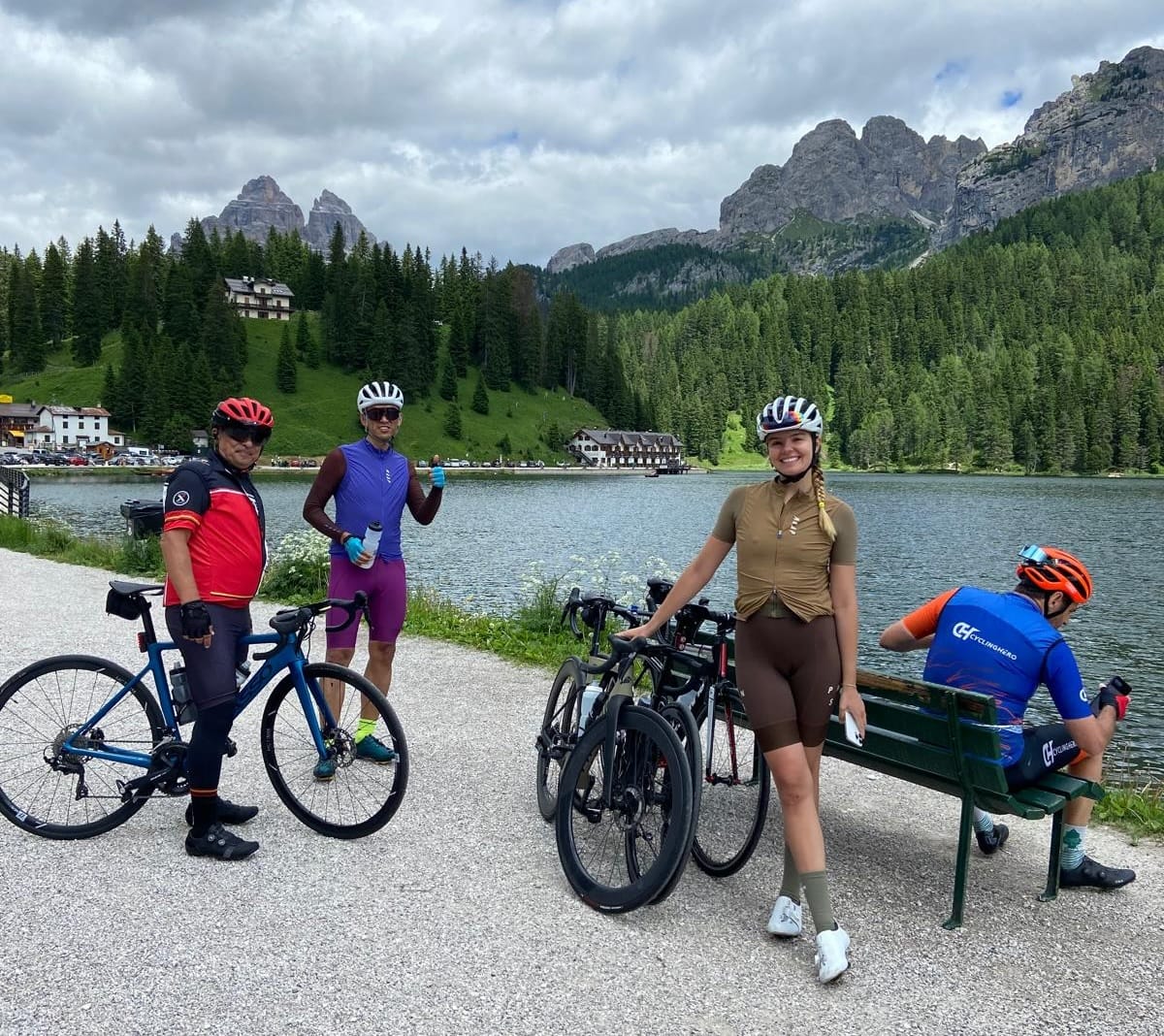
Here’s what’s in store if you decide to accept the Tre Cime di Lavaredo challenge:
After a short hard uphill right after leaving Misurina, the road actually goes downhill for a bit, making it clear that the almost 9% average gradient is averaged over the whole distance, including the downhill. DOH!
There is no other way to put it, the last section up to the Rifugio Auronzo is a showdown with gravity, and gravity brought an ebike. The only consolation is that there is relatively little traffic, due to this being a toll road and cyclists get in free. By the top you will probably envy the people in cars who paid €30 for the privilege of NOT riding it.
Take a moment to admire the views of the majestic Tre Cime Peaks from the Rifugio Auronzo before plummeting back down to Lake Misurina.
There is actually one more obstacle between you and Cortina, but this last push up to the Passo Tre Croci from this side is mercifully short. The last pass surpassed, tuck in for a wonderful sequence of curves back down to bustling Cortina, where a well-earned Aperitivo awaits.

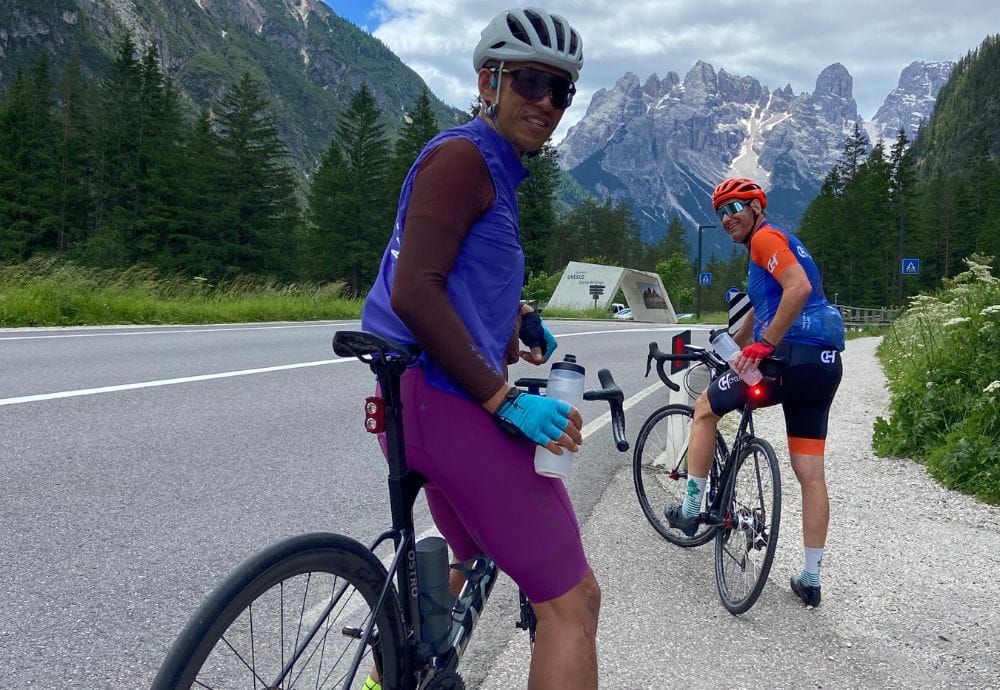
5. Passo Cibiana, Passo Staulanza, Passo Giau Loop from Cortina d'Ampezzo
Length: 95 km → 59 miles
Total climbing: 2820 m → 9250 feet
If you’re after one of the best cycling loops in the Dolomites, this ride serves up three legendary passes in one go. It starts off gently enough, with a mostly downhill roll out of Cortina, following sections of the scenic bike path converted from an old railway line. If you're finding the bike path a bit too slow, you can also just stick to the main road.
Shortly before Venas di Cadore, the route leaves this main road and crosses over the Boite river where the climbing begins. The Passo Cibiana is a medium-difficulty climb you should nonetheless treat with respect given the further challenges in store. Descending from the Passo Cibiana you enter the Val di Zoldo, a traditional mountain region seemingly lost in time.
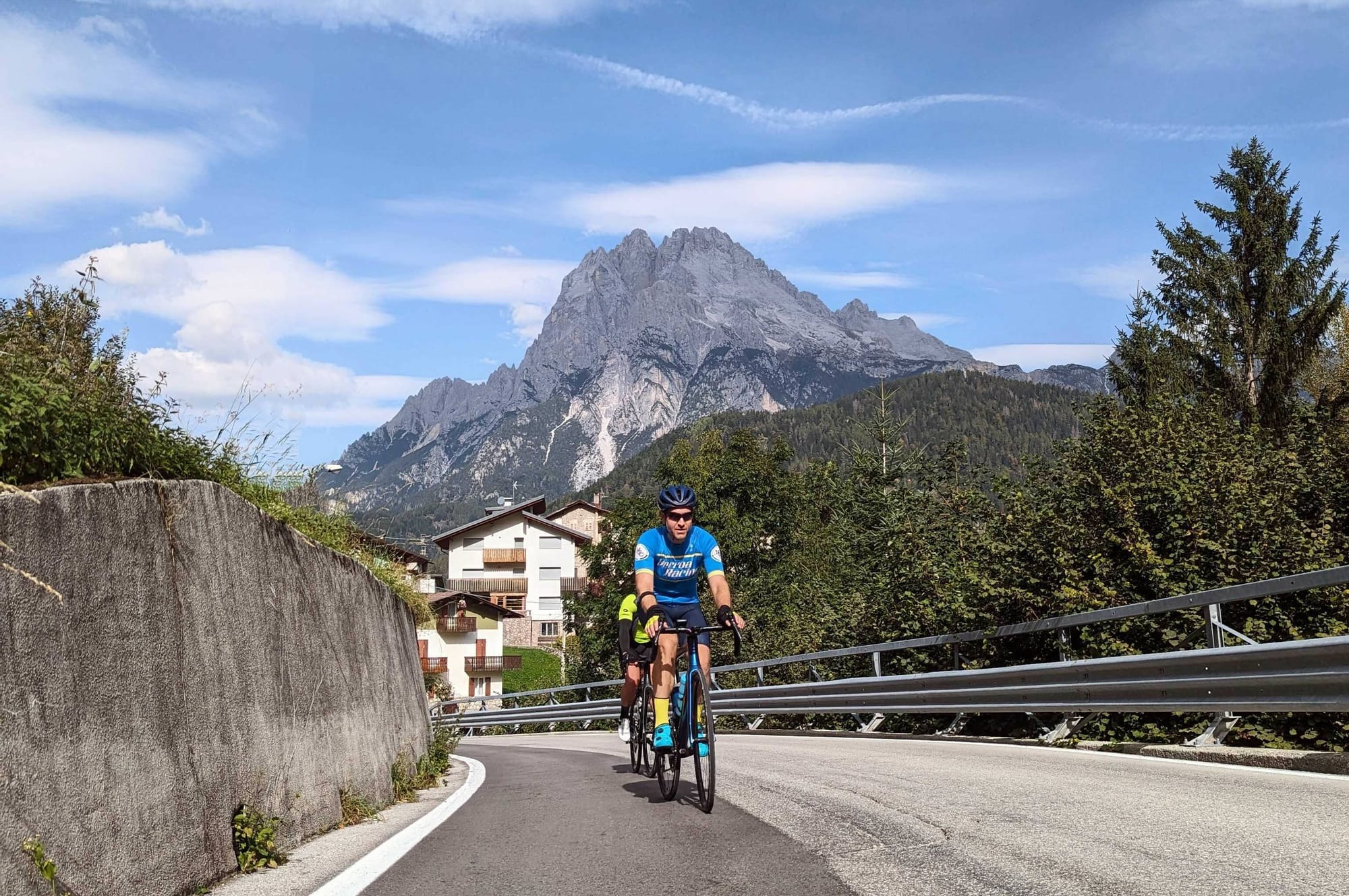
From Forno di Zoldo, it’s time for the longest climb of the day, the Passo Staulanza, a gradual climb where you can enjoy the views and light traffic as you ascend between the Monte Pelmo and the Monte Civetta. A glorious descent through pine forests brings you to Selva di Cadore, where you can stock up on water in the freshwater fountain.
Get ready for the final climb: the Passo Giau. As we went through it already above (see the second route in the list: Sellaronda (counterclockwise) plus Giau Loop from Corvara) I'll be providing just a brief summery here: 10 km → 6.2 miles at 10% average gradient. Nuff said.
Once at the summit, take a moment to soak in the unreal 360° views before hurtling down the other side. You can breathe a sigh of relief as you turn right this time at Pocol and continue downhill into Cortina.
Hang out on the Via Roma with your afternoon drink of choice. You’ve earned it!

Final Thoughts: Ride the Best of the Dolomites
These are not the only epic rides in the Dolomites. But if you go home having done the above routes, you will have ticked off many of the top bucket list climbs in the Dolomites, and experienced some of the most spectacular riding on earth.
I also have several lesser-known routes up my sleeve that didn't make the list but are fantastically beautiful and (sometimes) less demanding. If you’re looking for a truly unforgettable Dolomites cycling experience, join us on one of our next CyclingHero trips. We’ll make sure you ride the very best of what these mountains have to offer!
Why Ride the Dolomites with CyclingHero.cc?
- Expertly curated routes with multiple ride options for each day.
- A custom mobile app with GPX files, climb details, and insider tips to make your ride seamless.
- Boutique accommodations and daily in-person support, so you can focus on the ride.
Check out our Dolomites cycling tours and start planning your next cycling adventure in one of the world’s most breathtaking landscapes!
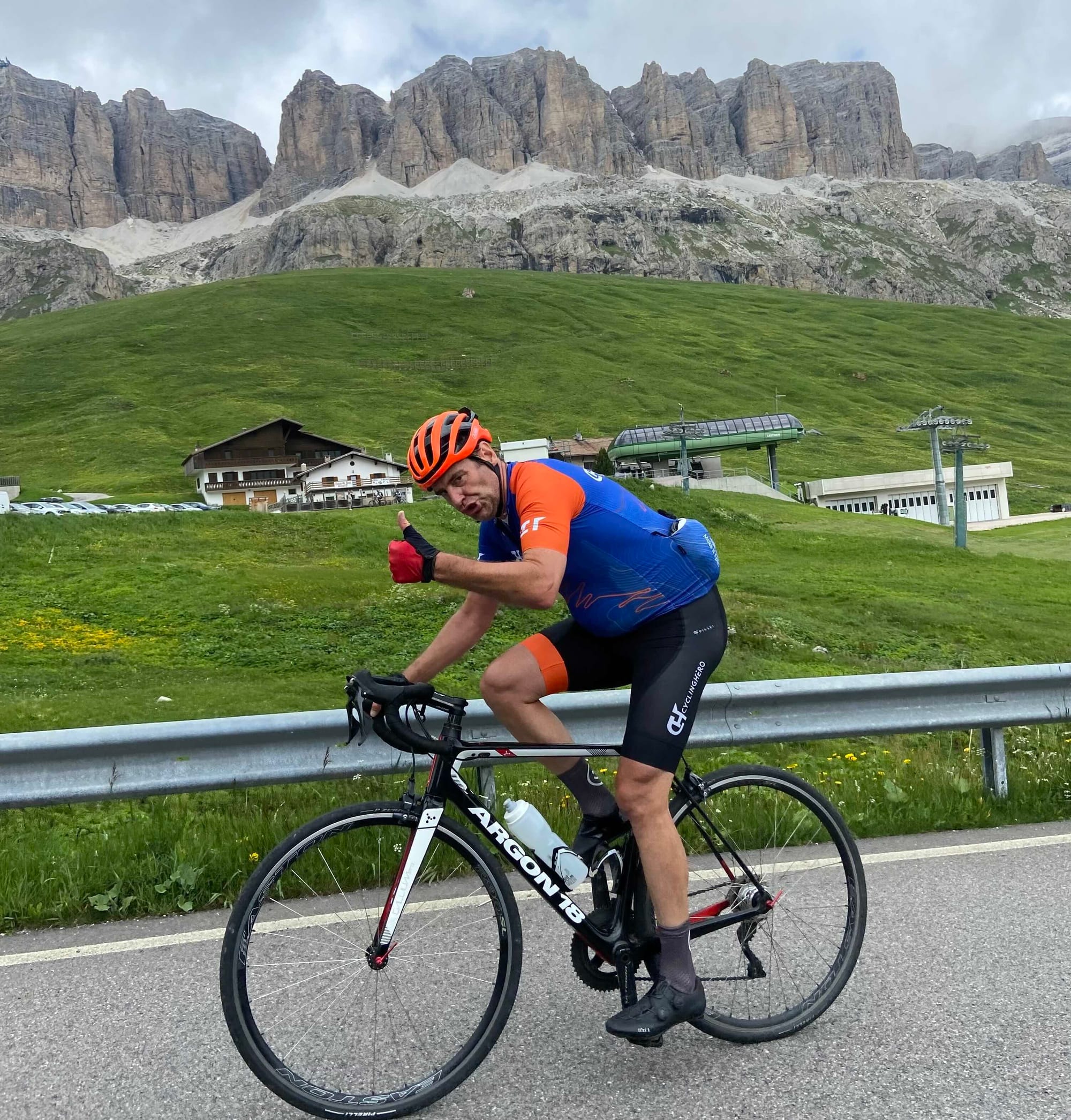

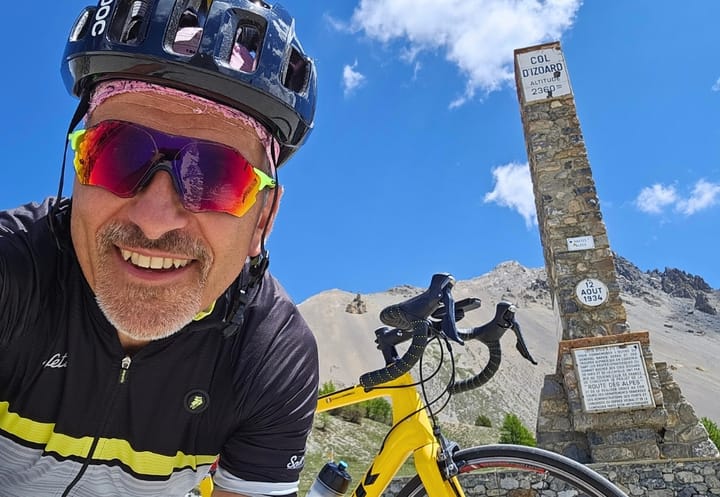
Comments ()